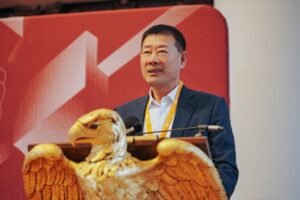China Aspires to Lead in AI Innovation

The Rise of AI in China
As China positions itself as a major player in the global technology landscape, artificial intelligence (AI) is at the forefront of this ambitious plan. The country’s leadership aims to make it the world’s leading AI hub by the year 2030. This aspiration is supported by a growing interest in AI technologies, observed even in the living rooms of families across China.
Children’s Interaction with AI
In a typical Beijing household, 8-year-old Timmy is engrossed in a game of chess against an AI-powered robot. He describes it as “like a little teacher or a little friend.” This reflects a broader trend in Chinese society where parents, like Timmy’s mother Yan Xue, are eager for their children to familiarize themselves with AI technology from an early age. Yan insists that understanding AI is essential for modern life, stating, “This is an inevitable trend that we will coexist with.”
AI Development Initiatives
China’s government is actively promoting AI development to rejuvenate its economy. At exhibitions in cities like Shanghai, various AI technologies are showcased. For instance, robots engage in soccer matches, although their performance remains imperfect as they occasionally require assistance when they fall.
The Role of Companies and Innovations
A notable player in the AI market is DeepSeek, a groundbreaking chatbot that gained recognition in January. This chatbot symbolizes China’s ability to develop advanced technology independently, especially in light of U.S. export restrictions on critical semiconductors. Experts see this achievement as a significant milestone for Chinese companies.
Educational Initiatives in AI
Additionally, many children in China are learning about robotics and coding at a young age. For example, an 8-year-old boy is designing a dinosaur robot, programming it to move and produce sounds. These educational robots are designed not only to entertain but also to impart knowledge to children from as young as three. As stated by Abbott Lyu, vice president of Whalesbot, “Other countries have AI education robots as well, but when it comes to competitiveness and smart hardware, China is doing better.”
Potential Economic Impact
DeepSeek’s introduction to the market has an estimated advertising value of over 10 billion yuan (approximately $1.3 billion) for China’s AI sector. This development underscores that AI is not merely theoretical—it’s a technology capable of transforming daily life and sparking curiosity among the public.
China’s Workforce Advantage
China boasts the largest number of graduates in fields such as science, technology, engineering, and mathematics (STEM), offering a unique advantage in the race for AI innovation. As technology firms map out their future directions, President Xi Jinping’s administration is heavily investing in advancements in AI and robotics. The need to innovate is underscored by competing with the United States in this vital sector.
Future Aspirations and the AI Landscape
Xi Jinping’s push for China to emerge as a leader in AI underscores a broader national strategy. With plans continuing to unfold, the release of innovative technology like DeepSeek serves as both a milestone and a motivation for ongoing development in AI fields. As the competition intensifies, efforts to secure an influential position in AI on the global stage will undoubtedly remain a priority for the Chinese government.
In summary, through early engagement with AI in education and robust support from the government, China is aiming to establish itself as a leader in artificial intelligence by the decade’s end. The rapid development of robotic competitors and advanced educational tools indicates a promising future for AI in the country.




